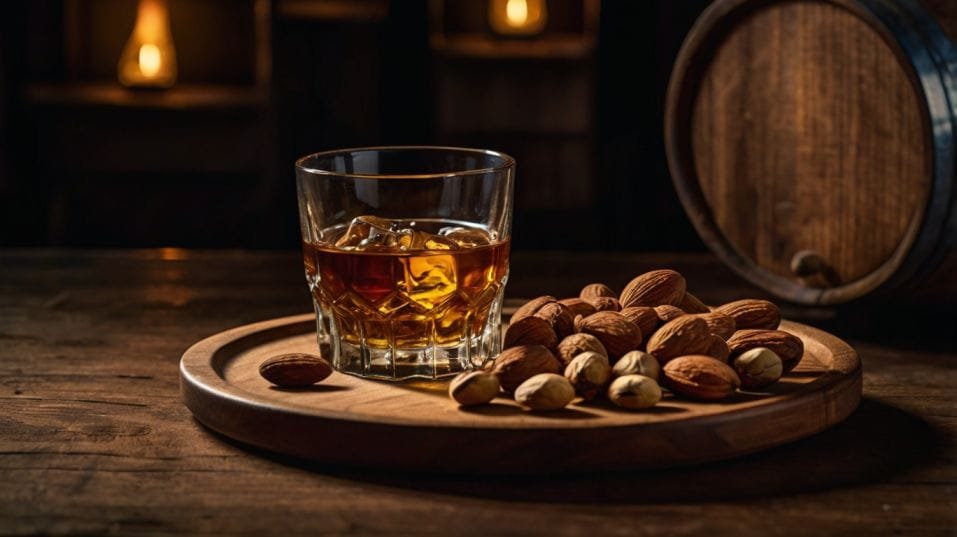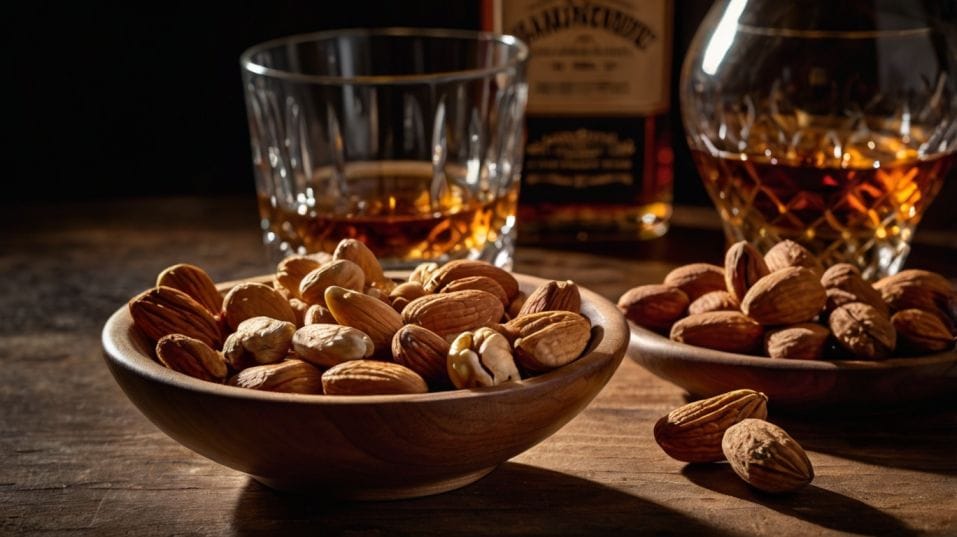Whiskey and Nuts: Simple, Perfect Pairings
Discover how simple nut pairings can transform your whiskey tasting. Learn to taste smarter and build confidence with every pour.

Ever wonder how to actually taste whiskey, not just drink it? Pair it with something deceptively simple—nuts. No fancy boards, no overpriced kits.
Just bold, accessible flavor that sharpens your palate and reveals the hidden depths in your pour.
For whiskey newcomers looking to taste with confidence, this one change can flip your whole experience. The secret isn’t in the bottle. It’s in what you eat with it.
Why Nuts and Whiskey Make Sense
You’re not looking for gimmicks. You want something that teaches your palate while enhancing the whiskey. Nuts are ideal for one simple reason: fat meets fire.
Fat smooths alcohol. Texture slows things down. Salt clears the slate. Each of these factors lets you taste more of what the whiskey is actually doing—especially those subtle shifts between sweet, bitter, smoky, and spicy.
That matters because whiskey is layered. It's built to evolve in the glass and in your mouth. A good nut pairing doesn’t flatten that experience; it makes those layers more obvious. The richness of nuts brings out grain character.
Their texture emphasizes barrel notes. Their natural oils hold flavor on your palate long enough for you to actually think about what you’re tasting. In short: nuts make you a better taster.
Understanding the Flavor Mechanics
When you eat a nut, you're not just coating your mouth with fat—you’re rewiring the way you perceive flavor and texture.
The richness softens alcohol burn, which gives space for subtler notes to surface: fruit, vanilla, spice, smoke, wood, and grain.
Contrast is the real power here. A high-proof rye might feel aggressive on its own, all cinnamon and ethanol. Add a walnut?

The tannin in the nut mirrors the oak in the barrel, flattening the heat and pulling spice into focus. A soft cashew with a peated Scotch slows the finish, shifting the smoke from harsh to aromatic.
What you're doing isn’t matching—it’s balancing. You’re using one ingredient to change the weight and behavior of another. That’s where pairing becomes a tool, not just a trick.
How to Think About Texture
Don’t underestimate the role of crunch. Texture in food doesn’t just affect mouthfeel—it affects perception. A dry-roasted almond cracks with sharpness.
It tightens your jaw, focuses your taste. Now sip a mellow Irish whiskey. Suddenly the fruit notes pop, the oak gets more defined, and the finish feels cleaner. That’s the nut doing its job.
By contrast, smooth nuts like macadamia or Brazil nuts coat your mouth, slowing down your ability to taste changes. This can be great for young, aggressive whiskeys that need tempering.
It’s like a filter—rounding off the raw edges so you can actually get to the flavor underneath.
Use texture intentionally. Want to pull a whiskey into sharper focus? Crunch. Want to soften the ride? Creamy.
Salt: Palate Reset or Flavor Multiplier?
Salt is a double-edged tool. Used well, it keeps your palate fresh and makes sweet or oaky notes more vibrant.
Used too heavily, and it flattens nuance and overwhelms subtleties in lighter whiskeys. Lightly salted almonds or peanuts are often the perfect balance—enough to cleanse without smothering.
A pinch of sea salt with a sweet bourbon makes the caramel and vanilla feel deeper. A salted cashew with a smoky Islay can create a weirdly satisfying sweet-savory echo—almost like BBQ in your mouth.
If you’re tasting multiple whiskeys, salt can be your best friend between pours. It sharpens your ability to detect differences.
But don’t get lazy. Salt is not a fix-all. It should support the whiskey, not compete with it. Always taste the whiskey on its own first. Then add a bite, then a sip. Pay attention to how things shift.
Roasts, Smokes, and Sweet Coatings: Proceed with Purpose
Not all nuts play fair. Roasting, smoking, and sweetening can change a nut’s behavior completely—and that means your whiskey will react differently, too.
These aren’t upgrades or flavor bombs. They’re variables. Use them intentionally, or they’ll hijack the pour.
Start Light, Then Go Deep
Lightly roasted nuts are where you start. They bring flavor without interference. They warm up the palate without dominating it.
As you build confidence, try pushing into darker roasts, smoked nuts, or spiced variations—but only if your whiskey can handle the weight.
Match Intensity with Intensity
Heavily roasted or smoked nuts need bolder whiskeys. Think high-proof bourbons, ryes, or anything with peat.
A smoky almond can amplify charred oak or double down on barrel spice—but pair it with a delicate grain whiskey, and you’ve just drowned the spirit.
Skip the Sweet (Usually)
Avoid sugar-coated or candied nuts unless you’re intentionally pairing with a whiskey that’s sharp, dry, or high in proof. Even then, tread lightly. You’re not making dessert. You’re building contrast.
Tasting as Practice, Not Performance
You don’t need a crowd, a checklist, or a tasting mat. You need curiosity and a willingness to notice. Try a whiskey you know well—one that you’ve already tasted solo—and pair it with a single type of nut.
Take a sip. Take a bite. Then sip again. Ask yourself: What changed? What showed up? What disappeared?
That’s the foundation of confident tasting. Not knowing the right answer, but knowing what to look for. Pairings like this sharpen your senses over time.
They make you quicker at recognizing barrel characteristics, better at spotting flaws, and more confident in what you like—and why.
This is also where collecting starts to mean something. You’re not buying bottles for labels or hype. You’re buying them because you understand how they behave—and how they evolve in your glass.
Final Thoughts: Try It, Taste It, Trust It
This isn’t about building a perfect pairing board. It’s about building awareness. Every whiskey you try becomes more interesting when you challenge it with something real. Every nut you taste becomes a tool for learning—not just a snack.
Start simple. Pour a whiskey you’ve had before. Try it with a peanut. Then an almond. Then a pecan. Notice what changes. That’s your palate getting sharper. That’s you tasting with intention.
There’s no trick to this. No secret code. Just one pour, one bite, and the attention to listen to what your mouth is telling you. Start today. Pair something. Taste better. Keep going.




